My mother's grandparents
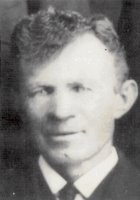 George C. Sees, born July 24, 1865 George C. Sees, born July 24, 1865Parents: John and Susan Süß | 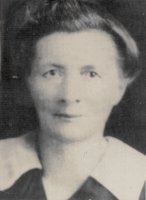 Elisabeth Keller Sees, born December 7, 1866 Elisabeth Keller Sees, born December 7, 1866Parents: Andrew and Elisabeth Keller |
For a couple of weeks, the Pondering Pig has been writing about Willa Cather. Cather's O Pioneers and My Antonia describe Nebraska during the days when my four sets of great-grandparents were establishing themselves there. And recently, I've been discussing the Gordon (Nebraska) area with Runaway Imagination. His father's people were from Western Nebraska.
I've been meditating on these things, and as I was putting away some photographs yesterday, my hands fell upon the photos of the little German villages my great-grandparents came from. From thence, the following...
_ _ _ _ _ _ _
We spent a few days visiting Dellfeld and Nünschweiler, Germany in November of 1990. The two little villages are located across a field and over a hill from each other in Rheinland-Pfalz near Pirmassens and Zweibrucken. Great-grandma Sees was born in Dellfeld and Great-grandpa Sees was born in Nünschweiler.
We were living in Berlin with my husband's job, and we rented a car and drove out into west Germany, almost to France. Keely was five years old, so she has some memories of the trip, and Isaac was about 16 months.
I labeled the photos I took there and wrote six pages about the trip. When I looked at the notes and photos again yesterday, I was surprised how much I had forgotten about our visit there. Those memories would be gone forever if I hadn't written them down. At the time I did all that documentation to share the experience with my mother. Now I find I was writing for myself as well!
Here are a few images from Dellfeld where Elisabeth Keller was born.
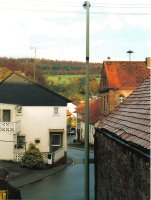 Dellfeld street and countryside Dellfeld street and countryside | 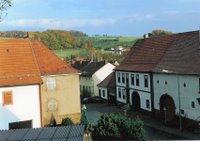 Dellfeld as seen from the cemetery Dellfeld as seen from the cemetery |
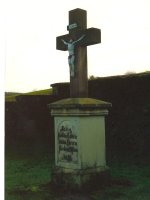 In the Dellfeld cemetery In the Dellfeld cemeteryOur dead in God, 1856 (poor translation) | 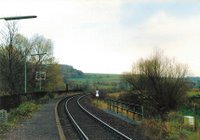 Outskirts of Dellfeld Outskirts of Dellfeld |
And here are some photos from Nünschweiler, the childhood home of George Süß. The name was also spelled "Süss". George americanized it to "Sees" because, he said, no one knew how to pronounce or write his German name.
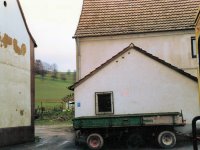 Nünschweiler is still a farming village. Nünschweiler is still a farming village. | 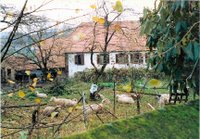 Seen from the back of the cemetery Seen from the back of the cemetery |
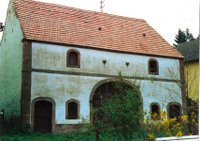 A barn in Nünschweiler A barn in Nünschweiler | 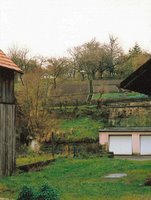 Hillside gardens Hillside gardens |
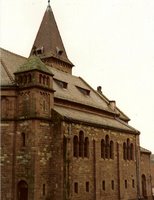
This old church in Nünschweiler would have been around during my great grandparent's time! I believe it is a Lutheran church. George and Elisabeth were Lutherans and they converted to Methodism in Gordon, perhaps in one of the tent revival meetings of that day.
An interesting side story about Elisabeth: as a young girl, Elisabeth was a maid in a house near (or next to) a convent. She learned that children lived in the convent, and she believed their parents to be priests and nuns. Whether or not this was the case, the purity of the Catholic Church was forever tainted in her eyes.
George came to America first and worked for a few years building railroads in the American west. My mother always said that he was about to be conscripted into the German army when he made a break for America. Cousin Alta (like my mother, a Sees grandchild) had a story about George stowing away on a ship. Supposedly, he got so hungry he had to come out, and the captain allowed him to work in return for his board and keep for the rest of the voyage. I view this story with some skepticism, having disproved a similar stowaway story on the other side of my family.
After a few years in America, George decided he needed a wife, so he traveled back to Germany and chose a German girl who was working in Dellfeld, just over the hill from Nünschweiler, the village where he grew up. I don't know whether they were acquainted with each other already or if someone made the arrangements. George and Elisabeth had to leave Germany quickly because when the local government found he was home, they tried again to put him in the army.
George and Elisabeth were married at St. Paul, Nebraska, but the ship's log for their voyage across the ocean shows that they registered as a married couple. Since Elisabeth came through customs as Elisabeth Suss, that is the name she gave for the marriage license.
America surely held more promise for Elisabeth than Germany did. After her father died suddenly at a young age (from a burst appendix), her mother married a man who raped Elisabeth's twin sister. She died from her injuries, as I understand it. (This was discussed at a Sees cousins' reunion that I attended in about 2000.) I don't know what age the girls were when this happened.
Then Elisabeth's mother died as well, leaving Elisabeth and her brother Andrew orphans. Cousin Alta thinks that Elisabeth's mother also suffered a burst appendix. At any rate, when Elisabeth decided to go to America and marry George, she was on her own without mother or father, and she was earning a living as a servant.
During their first year of marriage, George amd Elisabeth lived with and worked for a cousin of George's near Grand Island, Nebraska. Later, they lived near St. Paul, Nebraska, where an infant daughter (Caroline) was buried. Thereafter, they lived in New Mexico for a while, and then Agenda, Kansas, before finally buying a farm at Gordon. By then, there were five children.
America surely held more promise for Elisabeth than Germany did. After her father died suddenly at a young age (from a burst appendix), her mother married a man who raped Elisabeth's twin sister. She died from her injuries, as I understand it. (This was discussed at a Sees cousins' reunion that I attended in about 2000.) I don't know what age the girls were when this happened.
Then Elisabeth's mother died as well, leaving Elisabeth and her brother Andrew orphans. Cousin Alta thinks that Elisabeth's mother also suffered a burst appendix. At any rate, when Elisabeth decided to go to America and marry George, she was on her own without mother or father, and she was earning a living as a servant.
During their first year of marriage, George amd Elisabeth lived with and worked for a cousin of George's near Grand Island, Nebraska. Later, they lived near St. Paul, Nebraska, where an infant daughter (Caroline) was buried. Thereafter, they lived in New Mexico for a while, and then Agenda, Kansas, before finally buying a farm at Gordon. By then, there were five children.
My mother said her father, Harry Sees, told a story about the arrival of the Sees family in Gordon. As the train pulled in, her father observed some Indians chasing down a stray dog. When they caught it, they butchered it and cooked it over a fire.
I am not sure where George and Elisabeth homesteaded, but it was near Gordon, Nebraska. The land is now owned by descendants of the oldest daughter, Elva Sees Hix.
George knew some English already when he came to America, and he improved it while working on the railroads. (Alta thinks that George's mother may have been English in nationality. I don't know anything to either prove or disprove this. My mother's family tree papers show that George's mother was Susanna Steffan, but no other information is given -- not even a date of birth or death.)
Elisabeth spoke only German when she came to America, and she didn't learn English until her children went to school. Then she made them teach her each night what they had learned at school that day.
My mother told a story about World War I when anti-German sentiment was running high. A group of unfriendly people gathered outside the George Sees farmhouse one night. (I don't know how many people were in the crowd, but I'll bet most of them had been drinking.) My great-grandfather took his citizenship papers in hand and shook them at the people who dared to threaten his family and farm. This is the part of the story that I remember best, but my brother says that George also let the crowd in his yard know that he and his three strong sons (including my Grandpa Harry) would return in kind any damage that they suffered. The thugs left, and that was the end of it.
Another story my mother told was about George's bother Jakob. He came to visit from Germany but he didn't like it in America so he went back home. Elisabeth told my mother that Jakob set his boots outside his bedroom door, expecting her to clean them, but she ignored them. Elisabeth said Jakob seemed to think he was still in Germany, but she was an American woman!
Elisabeth's influence on my mother was significant because Mama's mother, Violet Eaton Sees, had passed away when Mama was eight years old. When my mother went to high school, she lived in town with George and Elisabeth, who were getting older and needed some help. Mama talked about doing many chores for them, particularly taking care of the chickens and cleaning the henhouse. During the four school years she lived with them, she was tutored in the family stories by her grandparents.
When I learned some German, I recognized the German influence in my mother's speech. I think she picked up the German words and idioms from her grandparents as well as her father.
As World War II approached and Nazi Germany began to flex its muscle, George and Elisabeth blamed power-hungry political and military leaders. They shook their heads and said, "It isn't the people, it isn't the people!" They did not live long enough to witness the horrors of World War II. George passed away on July 27, 1940, and Elisabeth passed away on August 26, 1940.
George and Elisabeth Sees are buried in the Gordon cemetery, on the south side. I don't know what George died from, but my mother thought Elisabeth may have had undiagnosed leukemia. (Leukemia is the curse of the Sees family).
The last communication that my mother remembered with the German branch of the Süß or Süss family was after World War II. They wrote asking the Sees family at Gordon to send soap and other items that were unavailable in Germany. The items were sent, and that seems to have been the last communication.
I don't believe Great-grandma Elisabeth had much (if any) contact with her family after she left Germany. My mother never mentioned anything about the Kellers.
I was not able to meet any relatives when we visited the ancestral villages, but I did find some tombstones in the Nünschweiler cemeteries bearing the names Süß and Süss. There were several Jakobs. We were told of a Dr. Lora Süss from Dellfeld, but she seemed to be out of town and we were not able to return due to the limits of our schedule.
Later, my mother was contacted by descendants of a cousin of George Sees who had also visited Dellfeld and Nünschweiler doing family research. (This explains why the German lady at the Dellfeld post office told me that I was the second American who had come asking about the Süss family.) I believe the cousin's last name was Stenger, Stanger, or something along that line. (Please correct me, if you know.) Mama wrote down some family tree information and passed it on to them.
And there you have it, kids. I wrote it down for you. It's up to you to save it and pass it on. Just remember that my great-grandparents are your great-great grandparents.
Related post: Dellfeld and Nünschweiler
Updated 8/27/2010
Please let me know if additions or corrections should be made!

6 comments:
Are these Sees related to the Sees Candy Sees? (I hope I didn't overlook that in your post!)
No, I'm pretty sure they're not related. The name was originally spelled differently and George changed it. Thanks for reading all that, WIP. Isaac read the whole thing but he's related. :D
My Reed ancestor William was 48 when he emigrated from London on the ship "Defense" in July 1635 and arrived in Boston on 6 October 1635. He was accompanied by his wife Mabel Kendall (30) and three young children, George-6, Ralph-5 (from whom I and descended) and Justice-2.
One of Ralph's sons was John, a weaver (1660-1711). John had a son named Ralph (b.1686), who had a son named John (1712-1755). One of John's sons was Supply (1754-1846) who fought in the Revolutionary War. In 1985 I located his tombstone in Acworth, NH. My Reeds lived in the Boston area until Supply moved to NH. I believe he moved there because soldiers were often given land grants in what was then the "frontier" in lieu of pay.
One of Supply's sons was John (1783-1846), who was a founding member of the Mormon religion. I have confirmed this through a visit to the Mormon Genealogical Library in Salt Lake City. He was baptized into the Mormon faith in 1830, which same year it was founded. He is listed as a close friend of Joseph Smith and often harbored Smith in his house while the local gendarmes were hunting him. John did the ironwork on the first temple the Mormons built, in Kirtland, OH outside of Cleveland. In fact it is the only such temple still standing outside of Salt Lake City.
John is buried in Bonapart, IA, which is a little inland town not too far across the Mississippi River from Nauvoo, IL where the Mormons fled during the religious uprising.
One of John's sons was William Willard (1817-1887), who was born in Acworth NH and is buried in Gallands Grove, IA. His occupation is listed in the 1860 census as a blacksmith, and he built the first sawmill on Mill Creek. He founded a town called Manteno, IA that was cut in half when the railroad came through and does not exist today. However, the cemetery is still there, near the town of Gallands Grove. I visited his grave during a Reed family reunion nearby in 1991.
Two of William Willard's sons were Mormons and traveled to Salt Lake City.
Another of William Willard's sons was George Riley (1851-1917), who married Sarah Anne Frazier in 1872 and had 11 children.
An interesting side note is that Sarah Anne Frazier (my great-great grandmother) was born on Feb. 14, which is my birthday and also the date on which both my father (1971) and his father (1977) died.
One of William Willard's sons was my father's father William David (1893-1977), a.k.a. "Granddad Bill." Bill was born in Crawford, NE and died in Gordon where he lived most of his life. When he was young his family moved from Crawford to Dunlap, IA and then to Irwin and Leat, NE.
To my knowledge Granddad Bill never espoused any particular religious beliefs, although his two sons were raised Roman Catholic following the tradition of their 3rd generation Irish mother Mary Mae O'Rourk.
Mary Mae’s parents Dennis and Mary O’Rourk homesteaded near Gordon. Dennis died young, leaving his wife Mary to operating the ranch and raise their children on her own (no mean feat in the late 1800s!). She was known as an excellent horsewoman, and I believe my father was very close to her and loved her cooking. Dennis’ father Michael immigrated from Ireland to settle in Sheboygan Falls, WI in the mid 1800s, a few years before the great potato blight brought a great flood of Irish immigrants to the U.S.
Granddad Bill (with whom I spent the summers of 1959-60) was employed as a young man on the Bert Hull Ranch north of Gordon and hired on as a section laborer on the Chicago & Northwestern Railroad in 1915 out of Eli, NE. In 1916 he came to Gordon as Section Foreman, which position he held for 30 years. He was appointed Roadmaster out of Valentine, NE for the last five years of his working life and retired in 1951.
Bill was a member of the Gordon, Nebraska Lodge #169 of the I.O.O.F. (Oddfellows) since 1917 (Vice Grand July 1919; Noble Grand January June 1920; Past District Deputy Grand Master). He was elected to the Gordon City Council from 1937 until April 1939; resigned for personal business reasons. He was elected Mayor of Gordon in 1942; served until 1946. He was again elected to the City Council in 1962; served until 1966. He played an active part in helping develop the Antelope Creek Water Project and the building of a new Post Office, making a trip to Washington, D. C. to lobby for government support.
I was raised Methodist in the tradition of my mother Mildred Peacock (1919-1996), who was born in Plant City, FL.
My mom's mother was Ruth Phillips, whose great-great grandfather Reuben Philips [note change in spelling] (1795-1877) was a circuit-riding Methodist preacher, school teacher and teacher of "singing schools" throughout the mountains of western NC. I have a transcription of his autobiography.
An interesting fact is that ancestors five generations back on each side of my family were instrumental in spreading religions to the frontier west.
And so my Reed ancestors migrated westward from Boston because of the new Mormon religion, and they ended up in Gordon because of the railroad.
I was born in the Washington, DC area because the Great Depression made it hard for young folks to remain in small towns at the same time that New Deal programs created unprecedented opportunities for young people in the nation's capitol.
I hope this information will help you connect your Gordon ancestors to mine.
My husband's paternal grandmother was a Reed, and I believe she was Reformed Latter Day Saints (RLDS.) The people who became RLDS were Joseph Smith followers who stayed behind in Missouri when Brigham Young took the Mormons to Utah.
I did send my aunt an e-mail to ask her if she remembered your grandfather, but I am not sure they check their e-mail too often.
Can you reveal your husband's paternal grandmother's name? Or would you rather do that via email to keep this from public view? Mine is arniereed@gmail.com.
I sent you some info by e-mail, but I don't see any reason not to reveal her name. She was born Hester Reed. I don't have any information about when or where she was born, but I believe She and her husband came to the Kansas City area in the early or mid 1930's from Wisconsin, and I know they had lived in Rockport, Illinois before that.
Post a Comment